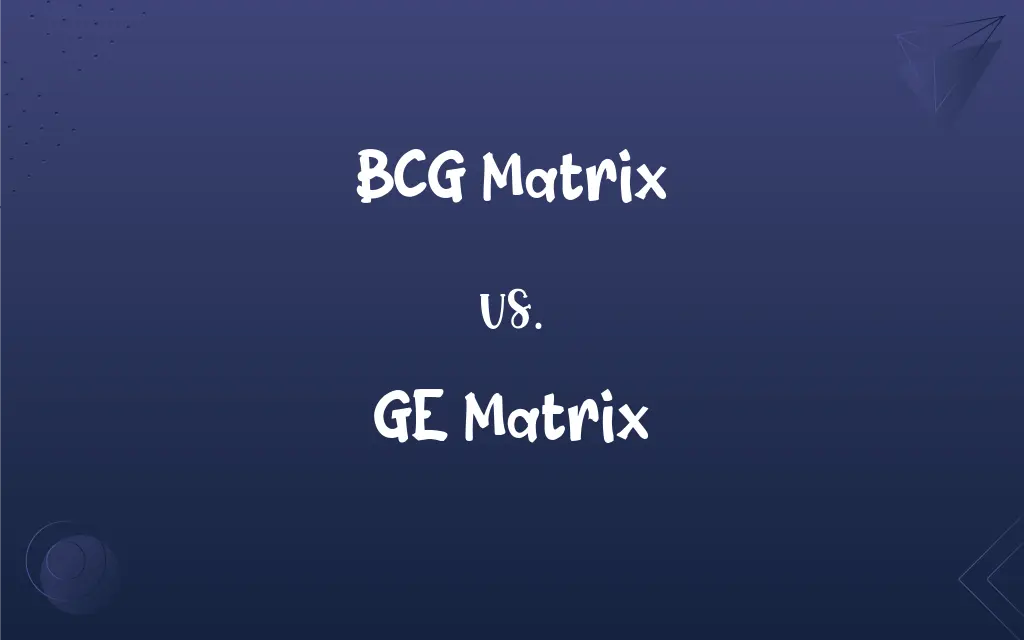BCG Matrix vs. GE Matrix: What's the Difference?
Edited by Aimie Carlson || By Harlon Moss || Published on November 3, 2024
BCG Matrix is a framework for analyzing a company's product portfolio based on market growth and market share. GE Matrix is a multi-factorial model evaluating business units on market attractiveness and business strength.

Key Differences
The BCG Matrix, developed by the Boston Consulting Group, categorizes business units or products into four quadrants. These quadrants are Stars, Cash Cows, Question Marks, and Dogs, based on market share and growth rate. The GE Matrix, developed by General Electric and McKinsey, is a more complex tool that assesses business units on two broad factors: market attractiveness and business strength, each divided into several components.
In the BCG Matrix, market growth rate and relative market share are the two critical dimensions. High market growth rate and high market share characterize 'Stars', while low market growth and high market share define 'Cash Cows'. Conversely, the GE Matrix uses multiple factors such as industry strength, market size, market growth, and competitive intensity to determine market attractiveness, and factors like product quality, market share, and marketing capabilities for business strength.
Decision-making implications differ between the two models. The BCG Matrix provides a simpler approach, suggesting investment, divestment, or maintenance strategies based on quadrant positioning. On the other hand, the GE Matrix offers a nuanced analysis, leading to more complex strategic decisions due to its multifactorial nature.
The BCG Matrix is often easier to implement due to its simplicity and clear-cut categorization. It's particularly useful for large businesses with diverse product lines. In contrast, the GE Matrix, with its detailed analysis, is suited for more complex business environments where multiple market and business factors need to be considered.
Both matrices serve as strategic planning tools, but their applicability varies depending on the business context. The BCG Matrix is ideal for a quick portfolio analysis and is easily understandable, while the GE Matrix provides a more detailed and customized business strategy guidance but requires more in-depth analysis.
ADVERTISEMENT
Comparison Chart
Basis of Evaluation
Market growth rate and market share
Market attractiveness and business strength
Complexity
Less complex, easier to use
More complex, detailed analysis
Components
Two dimensions (Market Growth, Market Share)
Multiple factors under two broad categories
Strategic Implications
Simple strategies like invest, divest, hold
More tailored and nuanced strategic decisions
Ideal Usage
Quick portfolio analysis, larger businesses with diverse products
Detailed analysis in complex business environments
ADVERTISEMENT
BCG Matrix and GE Matrix Definitions
BCG Matrix
A strategic tool categorizing products based on their performance and market dynamics.
Their 'Cash Cow' products were identified using the BCG Matrix, highlighting stable revenue generators.
GE Matrix
A model evaluating product lines using detailed market and business criteria.
Utilizing the GE Matrix, they realized some of their business units were in a strong position in attractive markets.
BCG Matrix
A framework for evaluating product portfolio based on market share and growth.
Using the BCG Matrix, they identified their new product as a 'Question Mark' due to its high market growth but low market share.
GE Matrix
A comprehensive tool used for analyzing a company’s business portfolio more intricately.
Through the GE Matrix, they could allocate resources more effectively to different business segments.
BCG Matrix
A tool to categorize business units as Stars, Cash Cows, Question Marks, or Dogs.
In the BCG Matrix, their flagship product was a 'Star', indicating high growth and high market share.
GE Matrix
A multifactorial tool for assessing business units based on market attractiveness and strength.
The GE Matrix helped them prioritize investments in business units with high market attractiveness and strength.
BCG Matrix
A matrix used for strategic business planning and resource allocation.
The BCG Matrix helped the company decide to invest more in their 'Star' products.
GE Matrix
A framework for complex strategic decision-making across different business units.
The GE Matrix analysis indicated the need for strategic changes in several mid-level attractive business units.
BCG Matrix
A method to analyze products in a company’s portfolio for effective management.
The BCG Matrix showed that they needed to divest from their 'Dog' products.
GE Matrix
An approach to classify business activities by considering various external and internal factors.
The GE Matrix's in-depth analysis revealed new growth opportunities in lesser-focused business areas.
FAQs
What is the BCG Matrix?
The BCG Matrix is a strategic tool for analyzing a company’s product portfolio based on market growth and market share.
How does the BCG Matrix categorize products?
It categorizes them as Stars, Cash Cows, Question Marks, or Dogs based on market share and growth rate.
Is the BCG Matrix easy to implement?
Yes, due to its simplicity and clear quadrant categorization.
Does the GE Matrix provide tailored strategies?
Yes, it offers more nuanced and customized strategic decisions.
What is the GE Matrix?
The GE Matrix is a complex model for evaluating business units based on market attractiveness and business strength.
How often should companies use the BCG Matrix?
Regularly, to keep track of product performance and market changes.
What type of companies benefit most from the BCG Matrix?
Large businesses with diverse product lines.
What factors does the GE Matrix consider?
It considers multiple factors under market attractiveness and business strength.
Why is the GE Matrix more complex?
Because it involves a detailed analysis of several factors for each business unit.
Can the BCG Matrix guide investment decisions?
Yes, it suggests whether to invest, divest, or hold based on quadrant positioning.
What is a major limitation of the BCG Matrix?
Its oversimplification of market dynamics.
Can startups use the BCG Matrix?
Yes, but it's more beneficial for businesses with multiple products.
What businesses are best suited for the GE Matrix?
Those in complex, competitive industries needing detailed analysis.
Can the GE Matrix identify new market opportunities?
Yes, through its detailed analysis of market attractiveness.
Is the GE Matrix static or dynamic?
It’s dynamic, adapting to changes in market conditions and business strengths.
Does the BCG Matrix consider industry attractiveness?
No, it focuses solely on market share and growth rate.
How does market change affect the BCG Matrix?
Market changes can shift products between quadrants.
Is the GE Matrix suitable for small businesses?
It can be overly complex for small businesses.
How does the GE Matrix help in resource allocation?
By evaluating business units' positions in different markets for strategic investment.
Do both matrices require market data?
Yes, accurate market data is crucial for both.
About Author
Written by
Harlon MossHarlon is a seasoned quality moderator and accomplished content writer for Difference Wiki. An alumnus of the prestigious University of California, he earned his degree in Computer Science. Leveraging his academic background, Harlon brings a meticulous and informed perspective to his work, ensuring content accuracy and excellence.
Edited by
Aimie CarlsonAimie Carlson, holding a master's degree in English literature, is a fervent English language enthusiast. She lends her writing talents to Difference Wiki, a prominent website that specializes in comparisons, offering readers insightful analyses that both captivate and inform.







































































